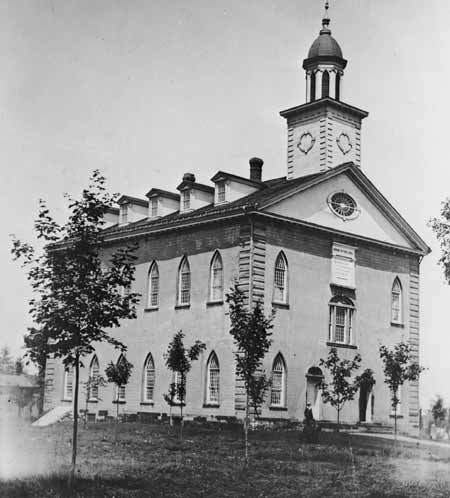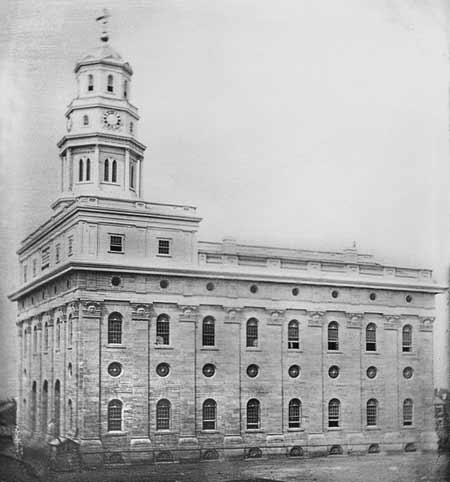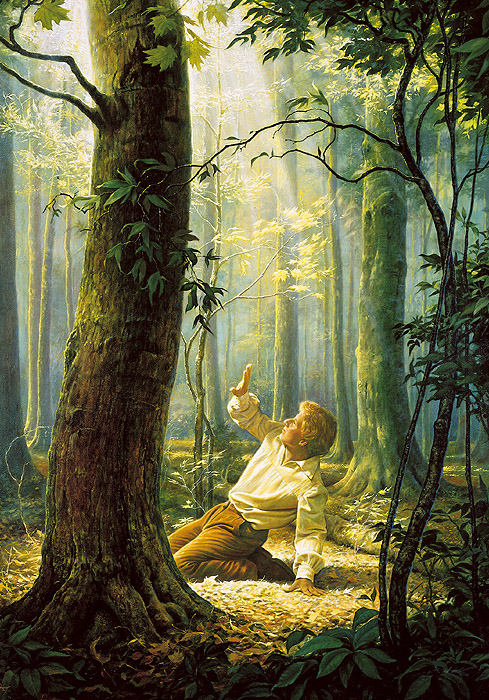What is Mormonism?
A Mormon Primer
The Story of Joseph Smith
Invariably when someone finds out I’m a Mormon, they ask me a slew of questions. What is you guys believe? What’s different about you? What’s the same? How many wives are you allowed to have?
There’s something—just—interesting about Mormons. They’re controversial, while at the same time, “normal.” How’s that possible?
In this book we’ll try to answer these questions. What is it that attracts the attention of the masses? Why are the Mormons considered to be controversial? Why do some revere the Mormons, while others despise them?
Of course, as a Mormon myself, you will most likely sense a positive bias in my presentation. However, I will try my best to provide a balanced view as much as I can. I will attempt to present different viewpoints, but along the way, I will also explain why I personally believe the way I do.
<Note to my friendly editors … I will most likely move some of these “disclaimers” to the foreword (which I’ll write last)>
Mormonism, in my opinion, is a Christian religion. Its doctrines are—I’d say—95% consistent with the doctrine of “mainstream” Christian religions. This includes the doctrines of the atonement. That is, Jesus Christ is the Son of God. He died for our sins, and it is only through Him that we can be saved. If we accept Him and follow his teachings, we can enter into the Kingdom of Heaven.
It also includes the concepts of baptism, communion, marriage, a belief in the Bible, the power and influence of the Holy Spirit, etc.
However, there’s another 5% that is “new.” These are the parts some consider to be controversial. In fact there may be many reading this today that would say, “5%? Bah! Try more like 60%, or even 90%.” To these readers, the 5% difference is very important stuff, even so much that perhaps Mormons should not be called Christians. This is an interesting discussion, which I’ll save for later. But for now, I’ll just agree that this 5% (or 90%) is of great interest to a lot of people.
This 5% includes the idea of prophets being alive today. It includes the introduction of new scripture: The Book of Mormon. It includes holy temples at a time when most Christian denominations don’t have them. Marriages are eternal instead of “till death do you part.” There are at least three levels of heaven instead of the binary heaven/hell. Angels and humans are two manifestations of our same existence instead of being separate. God, Jesus, and the Holy Spirit are three separate entities instead of being a single three-in-one entity. We are punished for our own sins instead of having “original sin.” And the list goes on and on.
So, how about we start at the beginning? I’ll start with a Mormon primer to introduce the non-initiate. Then I’ll follow a brother/sister set of twins throughout their lives as I present a “day in the life” of the typical Mormon. Keep in mind that this whole Introduction chapter will be mostly exposition, and hardly any discussion at all. That will come in the later chapters.
These introductions will be as brief, as the current goal is to set a backdrop. As you learn more about my religion, you will learn more about me and where I’m coming from. You will learn what my natural biases may be, and this knowledge will help you process the discussions that will follow in later chapters.
This exposition will only contain the briefest, most core, and important doctrines of my religion. The deeper and more controversial stuff (including polygamy) will be saved for later. After each section of exposition, I’ll provide some sources where you may be able to learn more details on your own.
Joseph Smith was born December 23, 1805 in Sharon, Vermont. By 1820, he had moved to Manchester, New York (near Palmyra). Around that time, the city was taken up in a religious upheaval. Only 14 years old, Joseph Smith didn’t know which church to join. His parents joined with the Presbyterians, and Joseph wished to join with the Methodists at first, but he became a little put off at the perceived dissensions between the denominations.
One night as he was reading the Bible, he came across James 1:5, which says: “If any of you lack wisdom, let him ask of God, that giveth to all men liberally, and upbraideth not; and it shall be given him.” He decided to ask God which church to join.
Then on a cool spring morning, he went out to the woods, where he figured he could pray vocally without being heard or interrupted. He started his prayer and continued on until his prayer was answered. God (the Father) and Jesus Christ (his son) appeared and told him not to join any church, for they were all wrong.
This forever changed Joseph Smith’s life and is the one defining moment that began what we Mormons call the Restoration of the Gospel. The belief is that Christ’s full original Church had died out with persecution in its earlier years. The Christians who remained preserved many of the tenets, but without guidance from living, appointed apostles, there was confusion and apostasy. The authority God had given to act in his name was lost, and Man was left alone to figure out doctrine on their own.
What transpired next was a series of stepping stones where Joseph Smith received pieces of the “Restoration” until the end of his life in 1844. I’ll briefly list these events in chronological order.
Springtime 1820: The First Vision (as described above).
September 1823: Joseph Smith was visited by an angel, Moroni, who described a buried record. The angel told Joseph he needed to get his life in order and that in four years he’d receive this record and would begin to translate them.
January 1827: Joseph Smith married Emma Smith, someone who becomes very important in later Church history.
September 1827: Joseph Smith acquired the buried record—golden plates—and began translating the writings into English. Several people, including Emma, and friends Martin Harris and Oliver Cowdery, helped in transcribing the words.
 |
| Emma Smith |
September 1827: Joseph Smith acquired the buried record—golden plates—and began translating the writings into English. Several people, including Emma, and friends Martin Harris and Oliver Cowdery, helped in transcribing the words.
March 1830: Joseph Smith had this work published under the name The Book of Mormon.
April 1830: Joseph Smith officially organized what would eventually become known as the Church of Jesus Christ of Latter Day Saints.
The church quickly gained followers and kindled persecutions from those who opposed the movement. Joseph Smith left New York and went to Kirtland, Ohio in 1831. Several followers, endearingly named “Mormons,” also settled in Kirtland. Later that year, Joseph Smith went to Jackson County, Missouri to begin another settlement. Thus, over the next few years Mormons gathered in both Ohio and Missouri.
 |
| Kirtland Temple |
December 1832: Joseph Smith began construction of the first temple in Kirtland, Ohio. It was finished in April 1836.
Persecutions continued. As early as 1833, the Saints (as we like to call ourselves) were driven out of Jackson County, Missouri into Clay County. Then in 1836, they were further driven to Caldwell County.
The Saints in Ohio lasted a little longer, being driven out in 1838. This group came to join the others in Caldwell County.
Toward the end of 1838, Joseph Smith and several of his friends were arrested, tried, and imprisoned, ultimately ending up in Liberty Jail in December. After months of living under subhuman conditions, a few benevolent guards allowed Smith and his friends to escape in April 1839.
During this same time, one church leader who was not imprisoned, Brigham Young, remained with the Saints. To flee persecutions, he helped lead the group to Illinois. After regaining his freedom, Joseph Smith reunited with the group, and then named their new city, Nauvoo.
Over the next few years, the Mormons took swamp land, overcame disease, and built a thriving small city. In 1840, they began working on their second temple.
 |
| Nauvoo Temple |
In 1844, Joseph Smith was arrested one last time along with his brother Hyrum Smith, and friends Willard Richards and John Taylor. They were held in the Carthage Jail for their “safety” as the trials proceeded. However, an angry mob stormed the jailhouse, and killed Joseph Smith and his brother.
| The Death of Joseph Smith |
Joseph Smith’s live ended, but the church grew stronger in his absence. Brigham Young became the new leader in his stead—directing the completion of the Nauvoo Temple—guiding the Saints away from persecution around 1846—and eventually leading them to arrive in Salt Lake City in 1847. There, after traveling a couple of decades in their own Trail of Tears, the Saints were finally safe from persecutions. In a few years, they took a desert and turned it into a thriving, and eventually large city.
Today, the church that Joseph Smith had started, the Church of Jesus Christ of Latter Day Saints, has become a large church with millions of followers from all around the world.
Sources on Joseph Smith:
“The Life and Ministry of Joseph Smith” from Teachings of Presidents of the Church: Joseph Smith, 2011: a good summary of the life of Joseph Smith.
“Joseph Smith—History” from the Pearl of Great Price: the writings of Joseph Smith giving his account of the First Vision and obtaining/translating the Book of Mormon.
“The First Vision: Searching for the Truth” by Ronald O. Barney. Published in the Ensign, Jan. 2005: a brief account of the First Vision and several artist’s depictions.
“Joseph and Emma: Moments in Their Lives.” Published in the Ensign, Jul. 2012: a brief and interesting summary of the interactions between Joseph Smith and his wife, Emma.
<More coming on the way…>
The Book of Mormon
The Nature of the Godhead
Our Existence: Before, Now, and Tomorrow

No comments:
Post a Comment